Model-independent search for $CP$ violation in $D^{0} \to K^{-}K^{+}\pi^{-}\pi^{+}$ and $D^{0} \to \pi^{-}\pi^{+}\pi^{+}\pi^{-}$ decays
[to restricted-access page]Information
LHCb-PAPER-2013-041
CERN-PH-EP-2013-151
arXiv:1308.3189 [PDF]
(Submitted on 14 Aug 2013)
Phys. Lett. B726 (2013) 623
Inspire 1247810
Tools
Abstract
A search for CP violation in the phase-space structures of D0 and D0bar decays to the final states K-K+pi-pi+ and pi-pi+pi+pi- is presented. The search is carried out with a data set corresponding to an integrated luminosity of 1.0fb^-1 collected in 2011 by the LHCb experiment in $pp$ collisions at a centre-of-mass energy of 7TeV. For the K-K+pi-pi+ final state, the four-body phase space is divided into 32 bins, each bin with approximately 1800 decays. The p-value under the hypothesis of no CP violation is 9.1, and in no bin is a CP asymmetry greater than 6.5 observed. The phase space of the pi-pi+pi+pi- final state is partitioned into 128 bins, each bin with approximately 2500 decays. The $p$-value under the hypothesis of no CP violation is 41, and in no bin is a CP asymmetry greater than 5.5 observed. All results are consistent with the hypothesis of no CP violation at the current sensitivity.
Figures and captions
|
Distributions of (\subref*{fig:mass:KKPiPi:D},\subref*{fig:mass:FourPi:D},\subref*{fig:mass:KThreePi:D}) $ m(hhhh)$ and (\subref*{fig:mass:KKPiPi:DELTAM},\subref*{fig:mass:FourPi:DeltaM},\subref*{fig:mass:KThreePi:DELTAM}) $\Delta m$ for (\subref*{fig:mass:KKPiPi:D},\subref*{fig:mass:KKPiPi:DELTAM}) $ D ^0 \rightarrow K ^- K ^+ \pi ^- \pi ^+ $ , (\subref*{fig:mass:FourPi:D},\subref*{fig:mass:FourPi:DeltaM}) $ D ^0 \rightarrow \pi ^- \pi ^+ \pi ^+ \pi ^- $ , and (\subref*{fig:mass:KThreePi:D},\subref*{fig:mass:KThreePi:DELTAM}) $ D ^0 \rightarrow K ^- \pi ^+ \pi ^+ \pi ^- $ candidates for magnet up polarity. Projections of the two-dimensional fits are overlaid, showing the contributions for signal, combinatorial background, and random soft pion background. The contributions from $ D ^0 \rightarrow K ^- \pi ^+ \pi ^- \pi ^+ \pi ^0 $ and $ D _{s}^{+} \rightarrow K ^- K ^+ \pi ^- \pi ^+ \pi ^+ $ contamination are also shown for the $ D ^0 \rightarrow K ^- K ^+ \pi ^- \pi ^+ $ sample. |
Fig1a.pdf [28 KiB] HiDef png [194 KiB] Thumbnail [163 KiB] *.C file |

|
|
Fig1b.pdf [32 KiB] HiDef png [181 KiB] Thumbnail [162 KiB] *.C file |

|
|
|
Fig1c.pdf [23 KiB] HiDef png [160 KiB] Thumbnail [149 KiB] *.C file |

|
|
|
Fig1d.pdf [26 KiB] HiDef png [152 KiB] Thumbnail [139 KiB] *.C file |

|
|
|
Fig1e.pdf [23 KiB] HiDef png [159 KiB] Thumbnail [148 KiB] *.C file |
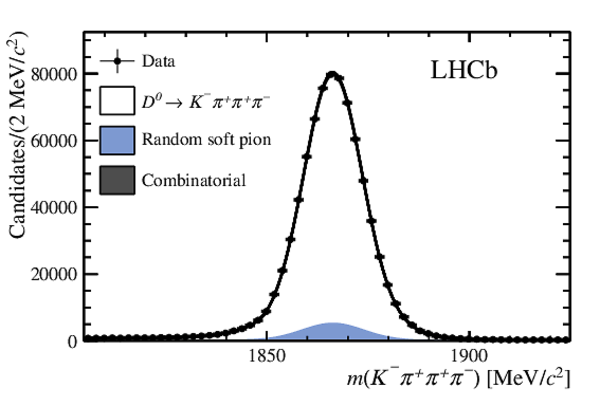
|
|
|
Fig1f.pdf [26 KiB] HiDef png [141 KiB] Thumbnail [130 KiB] *.C file |

|
|
|
Invariant mass-squared distributions for $ D ^0$ meson (black, closed circles) and $\overline{ D }{} ^0$ meson (red, open squares) decays to the final state $ K ^- K ^+ \pi ^- \pi ^+ $ . The invariant mass-squared combinations s(1,2), s(2,3), s(1,2,3), s(2,3,4), and s(3,4) correspond to s( $ K ^-$ , $ K ^+$ ), s( $ K ^+$ , $\pi ^-$ ), s( $ K ^-$ , $ K ^+$ , $\pi ^-$ ), s( $ K ^+$ , $\pi ^-$ , $\pi ^+$ ), and s( $\pi ^-$ , $\pi ^+$ ) , respectively for the $ D ^0$ mode. The charge conjugate is taken for the $\overline{ D }{} ^0$ mode. The phase-space distribution of the $ D ^0 \rightarrow K ^- K ^+ \pi ^- \pi ^+ $ decay is expected to be dominated by the quasi-two-body decay $ D ^0 \rightarrow \phi\rho^0 $ with additional contributions from $ D ^0 \rightarrow K _{1}(1270)^{\pm} K ^{\mp} $ and $ D ^0 \rightarrow K ^{*}(1410)^\pm K ^{\mp} $ decays [10]. |
Fig2a.pdf [15 KiB] HiDef png [135 KiB] Thumbnail [119 KiB] *.C file |

|
|
Fig2b.pdf [15 KiB] HiDef png [130 KiB] Thumbnail [119 KiB] *.C file |

|
|
|
Fig2c.pdf [17 KiB] HiDef png [155 KiB] Thumbnail [136 KiB] *.C file |

|
|
|
Fig2d.pdf [15 KiB] HiDef png [134 KiB] Thumbnail [122 KiB] *.C file |

|
|
|
Fig2e.pdf [16 KiB] HiDef png [152 KiB] Thumbnail [135 KiB] *.C file |

|
|
|
Invariant mass-squared distributions for $ D ^0$ meson (black, closed circles) and $\overline{ D }{} ^0$ meson (red, open squares) decays to the final state $\pi ^- \pi ^+ \pi ^+ \pi ^- $ . The invariant mass-squared combinations s(1,2), s(2,3), s(1,2,3), s(2,3,4), and s(3,4) correspond to s( $\pi ^-$ , $\pi ^+$ ), s( $\pi ^+$ , $\pi ^+$ ), s( $\pi ^-$ , $\pi ^+$ , $\pi ^+$ ), s( $\pi ^+$ , $\pi ^+$ , $\pi ^-$ ), and s( $\pi ^+$ , $\pi ^-$ ) , respectively for the $ D ^0$ mode. The charge conjugate is taken for the $\overline{ D }{} ^0$ mode. Owing to the randomisation of the order of identical final-state particles the invariant mass-squared distributions s(2,3,4) and s(3,4) are statistically compatible with the invariant mass-squared distributions s(1,2,3) and s(1,2), respectively. As such the invariant mass-squared distributions s(2,3,4) and s(3,4) are not shown. The phase-space distribution of the $ D ^0 \rightarrow \pi ^- \pi ^+ \pi ^+ \pi ^- $ decay is expected to be dominated by contributions from $ D ^0 \rightarrow a_{1}(1260)^{+} \pi^{-} $ and $ D ^0 \rightarrow \rho^{0} \rho^{0} $ decays [21]. |
Fig3a.pdf [16 KiB] HiDef png [146 KiB] Thumbnail [124 KiB] *.C file |

|
|
Fig3b.pdf [16 KiB] HiDef png [132 KiB] Thumbnail [108 KiB] *.C file |

|
|
|
Fig3c.pdf [16 KiB] HiDef png [152 KiB] Thumbnail [128 KiB] *.C file |

|
|
|
Distributions of $ S_{ C P }$ for \subref{fig:Toy:SCP:NoCPV} a typical pseudo-experiment with generated $ D ^0 \rightarrow \pi ^- \pi ^+ \pi ^+ \pi ^- $ decays without CPV and for \subref{fig:Toy:SCP:CPV} a typical pseudo-experiment with a generated 10$^{\circ}$ phase difference between $ D ^0 \rightarrow a_{1}(1260)^{+} \pi^{-}$ and $\overline{ D }{} ^0 \rightarrow a_{1}(1260)^{-} \pi^{+}$ resonant decays. The points show the data distribution and the solid line is a reference Gaussian distribution corresponding to the no CPV hypothesis. The corresponding $p$-values under the hypothesis of no asymmetry for \subref{fig:Toy:SCP:NoCPV} decays without CPV and \subref{fig:Toy:SCP:CPV} decays with a 10$^{\circ}$ phase difference between $ D ^0 \rightarrow a_{1}(1260)^{+} \pi^{-}$ and $\overline{ D }{} ^0 \rightarrow a_{1}(1260)^{-} \pi^{+}$ resonant components are 85.6% and $1.1\times10^{-16}$, respectively. |
Fig4a.pdf [14 KiB] HiDef png [69 KiB] Thumbnail [40 KiB] *.C file |
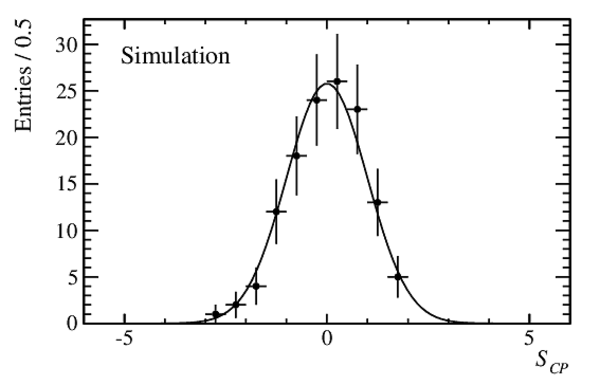
|
|
Fig4b.pdf [15 KiB] HiDef png [82 KiB] Thumbnail [49 KiB] *.C file |

|
|
|
Distributions of (\subref*{fig:SCP:KKPiPi},\subref*{fig:SCP:FourPi},\subref*{fig:control:SCP}) $ S_{ C P }$ and (\subref*{fig:RAW:KKPiPi},\subref*{fig:RAW:FourPi},\subref*{fig:control:RAW}) local $ C P$ asymmetry per bin for (\subref*{fig:SCP:KKPiPi},\subref*{fig:RAW:KKPiPi}) $ D ^0 \rightarrow K ^- K ^+ \pi ^- \pi ^+ $ decays partitioned with 32 bins, for (\subref*{fig:SCP:FourPi},\subref*{fig:RAW:FourPi}) $ D ^0 \rightarrow \pi ^- \pi ^+ \pi ^+ \pi ^- $ decays partitioned with 128 bins, and for (\subref*{fig:control:SCP},\subref*{fig:control:RAW}) the control channel $ D ^0 \rightarrow K ^- \pi ^+ \pi ^+ \pi ^- $ partitioned with 128 bins. The points show the data distribution and the solid line is a reference Gaussian distribution corresponding to the no CPV hypothesis. |
Fig5a.pdf [14 KiB] HiDef png [69 KiB] Thumbnail [38 KiB] *.C file |

|
|
Fig5b.pdf [14 KiB] HiDef png [73 KiB] Thumbnail [43 KiB] *.C file |

|
|
|
Fig5c.pdf [15 KiB] HiDef png [76 KiB] Thumbnail [45 KiB] *.C file |
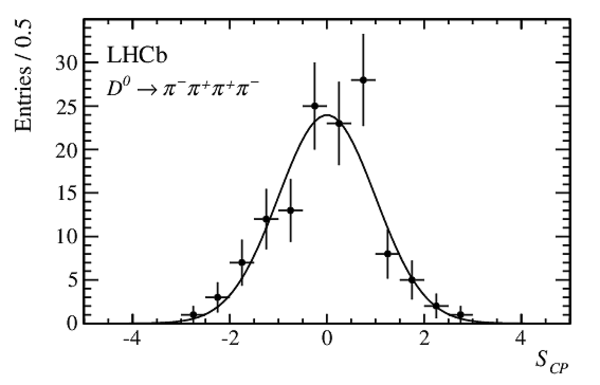
|
|
|
Fig5d.pdf [14 KiB] HiDef png [69 KiB] Thumbnail [42 KiB] *.C file |

|
|
|
Fig5e.pdf [15 KiB] HiDef png [76 KiB] Thumbnail [45 KiB] *.C file |

|
|
|
Fig5f.pdf [14 KiB] HiDef png [64 KiB] Thumbnail [38 KiB] *.C file |
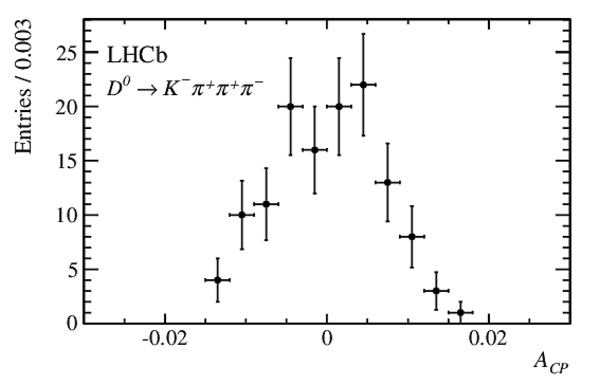
|
|
|
Animated gif made out of all figures. |
PAPER-2013-041.gif Thumbnail |

|
Tables and captions
|
The $\chi^2/\mathrm{ndf}$ and $p$-values under the hypothesis of no CPV for the control channel $ D ^0 \rightarrow K ^- \pi ^+ \pi ^+ \pi ^- $ . The $p$-values are calculated separately for data samples taken with magnet up polarity, magnet down polarity, and the two polarities combined. |
Table_1.pdf [31 KiB] HiDef png [54 KiB] Thumbnail [25 KiB] tex code |

|
|
The $\chi^2/\mathrm{ndf}$ and $p$-values under the hypothesis of no CPV with three different partitions for $ D ^0 \rightarrow K ^- K ^+ \pi ^- \pi ^+ $ decays and $ D ^0 \rightarrow \pi ^- \pi ^+ \pi ^+ \pi ^- $ decays. The $p$-values are calculated for a combined data sample with both data taken with magnet up polarity and data taken with magnet down polarity. |
Table_2.pdf [44 KiB] HiDef png [40 KiB] Thumbnail [19 KiB] tex code |

|
Supplementary Material [file]
| Supplementary material full pdf |
supple[..].pdf [449 KiB] |
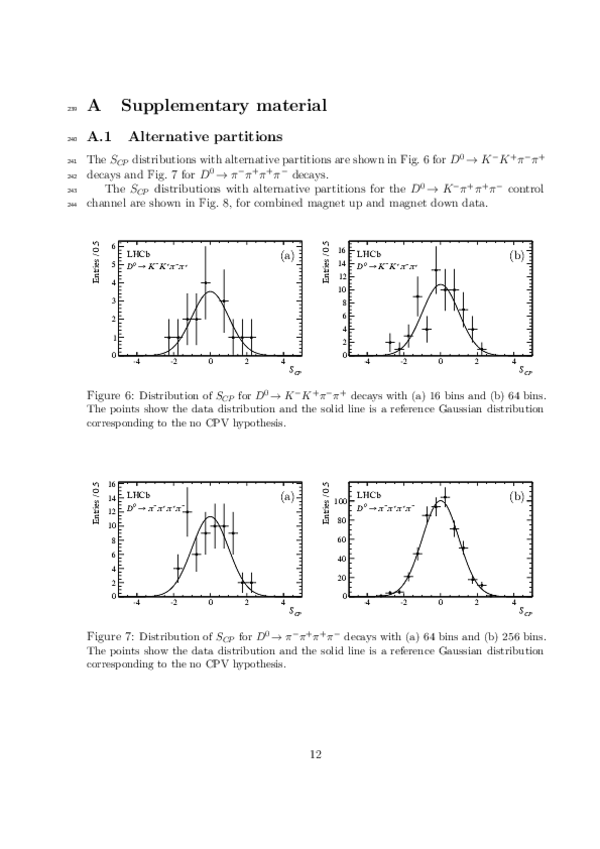
|
|
This ZIP file contains supplemetary material for the publication LHCb-PAPER-2013-041. The files are: Supplementary.pdf : An overview of the extra figures *.pdf, *.png, *.eps, *.C : The figures in variuous formats |
Fig10.pdf [38 KiB] HiDef png [260 KiB] Thumbnail [214 KiB] *C file |

|
|
Fig6a.pdf [14 KiB] HiDef png [71 KiB] Thumbnail [41 KiB] *C file |

|
|
|
Fig6b.pdf [15 KiB] HiDef png [77 KiB] Thumbnail [45 KiB] *C file |

|
|
|
Fig7a.pdf [14 KiB] HiDef png [76 KiB] Thumbnail [44 KiB] *C file |

|
|
|
Fig7b.pdf [14 KiB] HiDef png [76 KiB] Thumbnail [42 KiB] *C file |

|
|
|
Fig8a.pdf [14 KiB] HiDef png [80 KiB] Thumbnail [47 KiB] *C file |

|
|
|
Fig8b.pdf [15 KiB] HiDef png [93 KiB] Thumbnail [54 KiB] *C file |
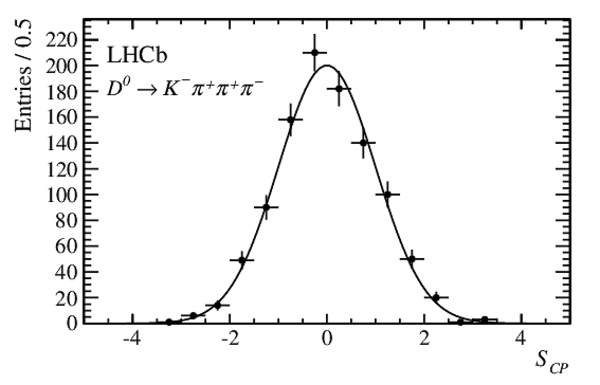
|
|
|
Fig9.pdf [21 KiB] HiDef png [189 KiB] Thumbnail [129 KiB] *C file |
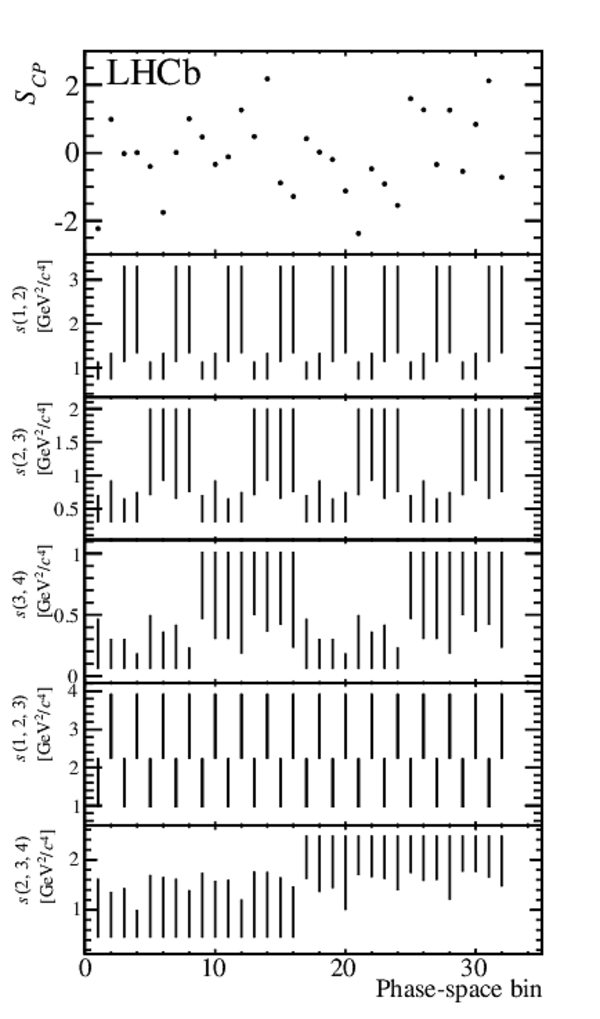
|
Created on 27 April 2024.
